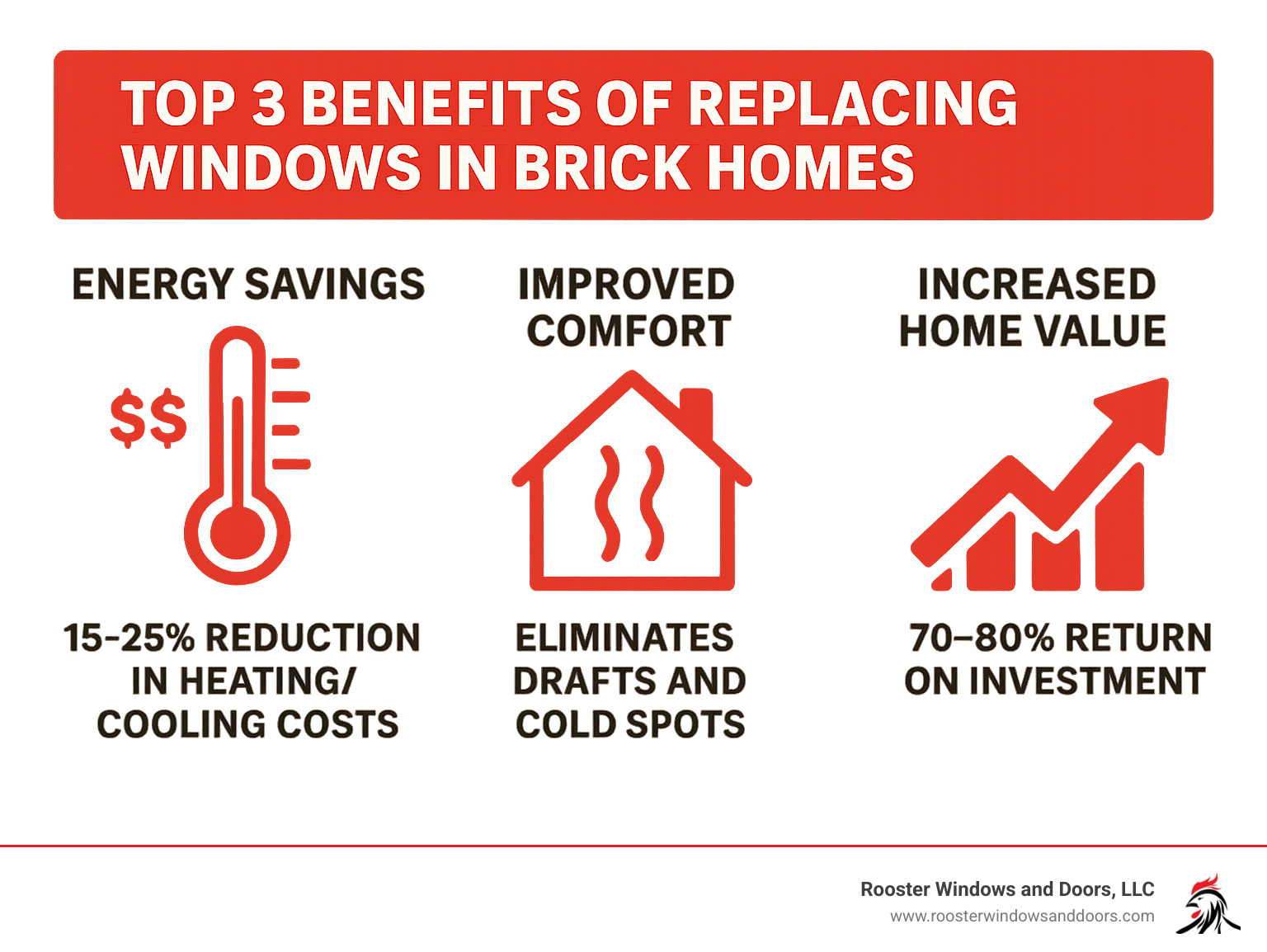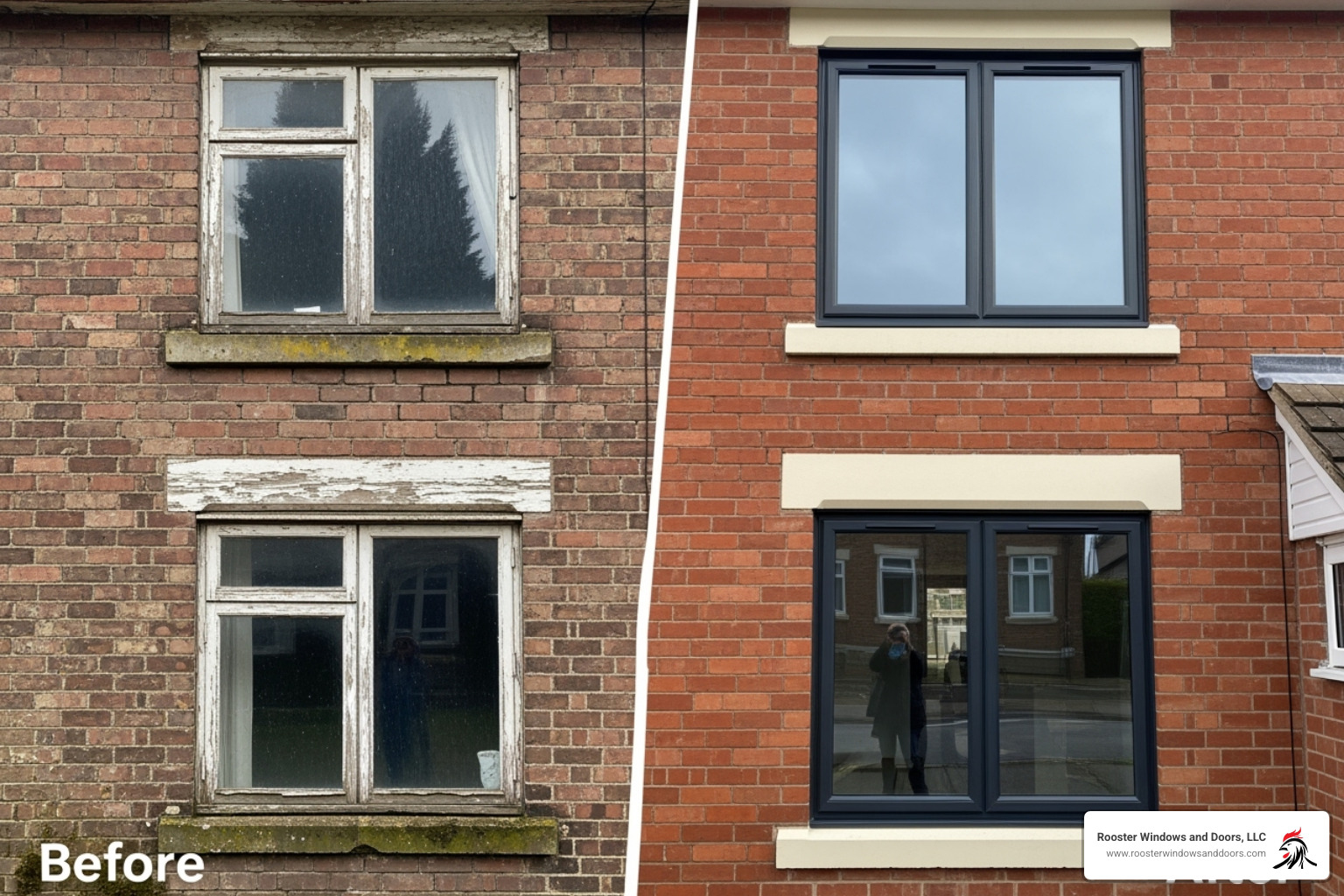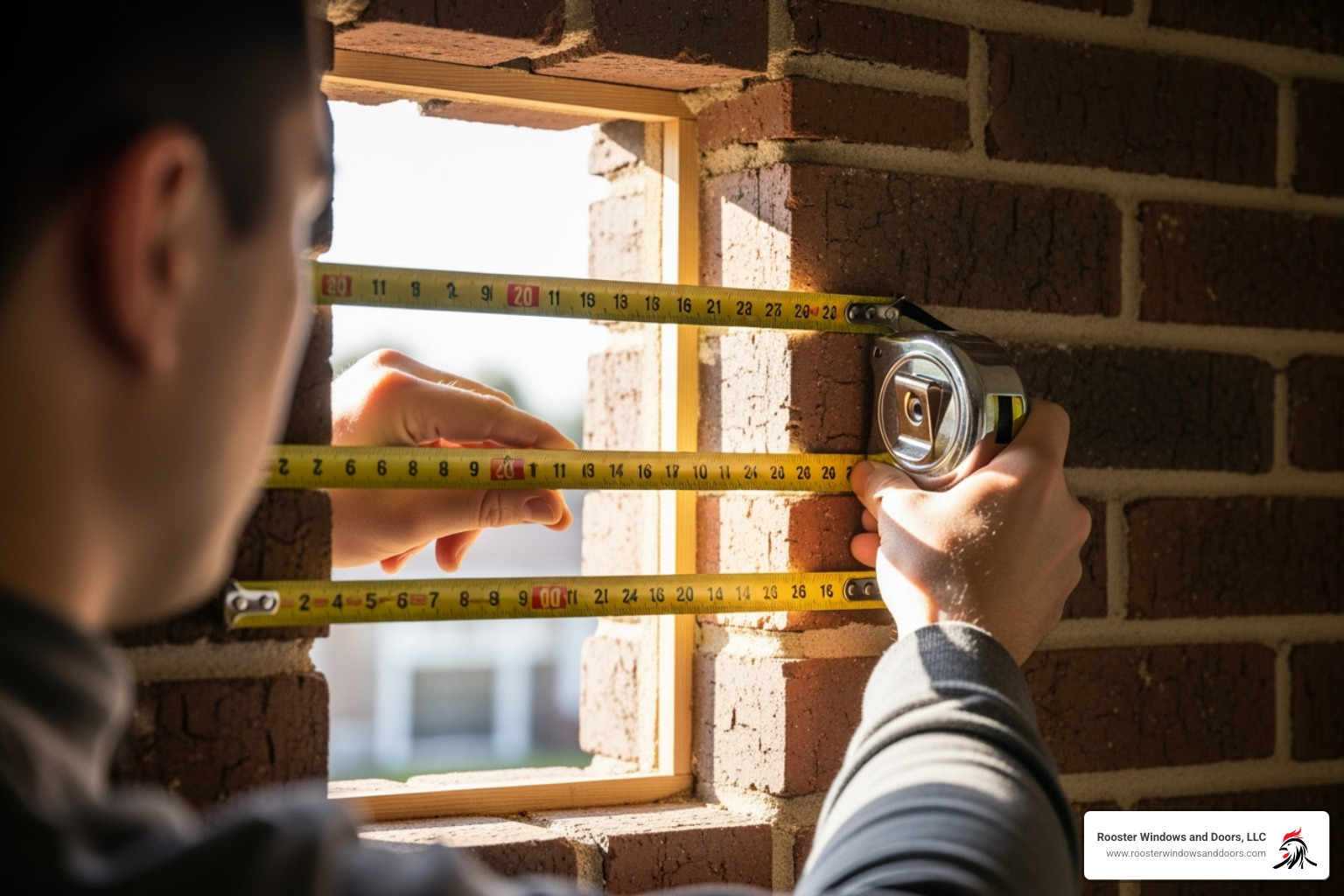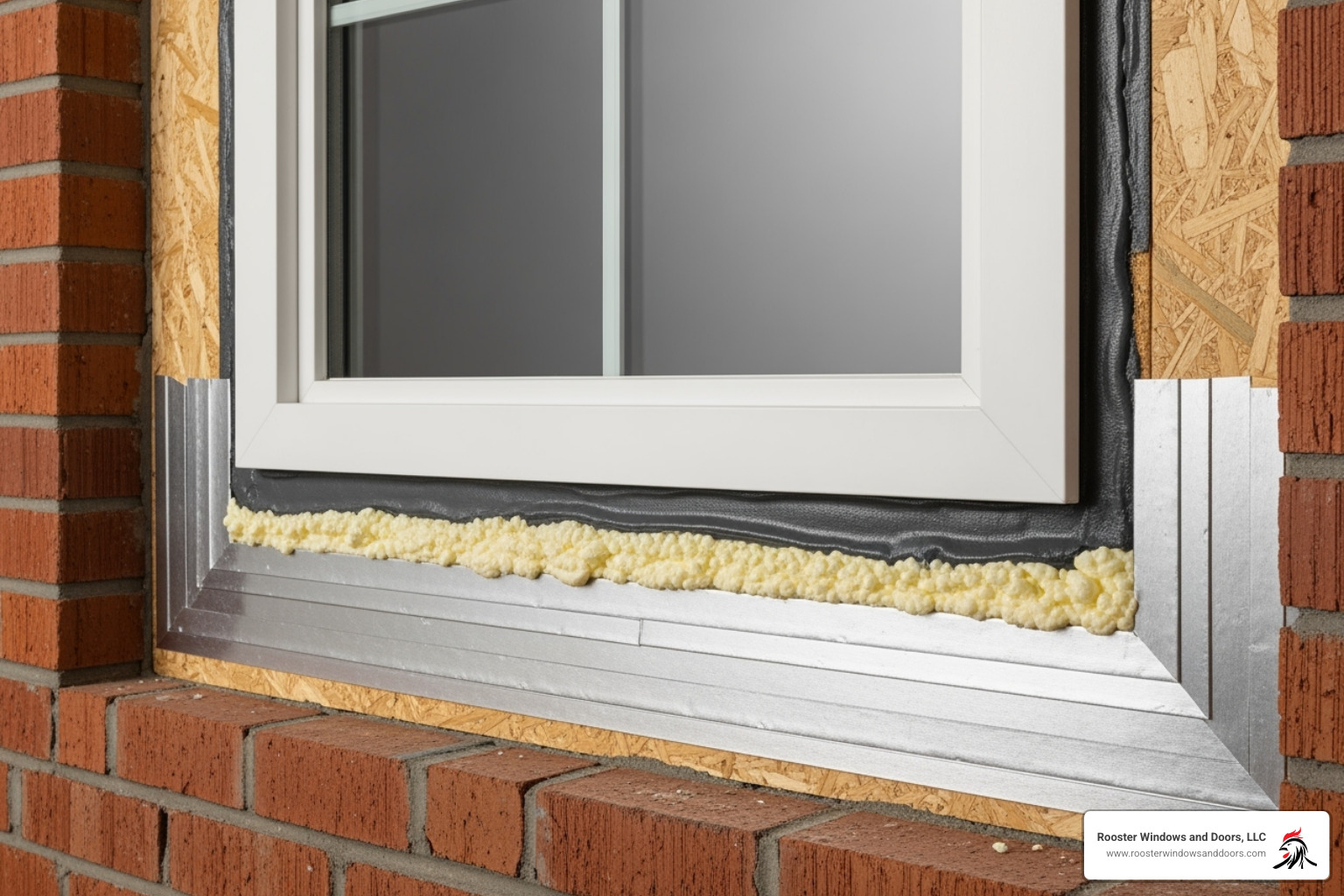Why Replacing Windows in a Brick House Requires Special Care
Replacing windows in a brick house presents unique challenges compared to standard projects. Unlike wood or vinyl siding, brick walls are fragile and unforgiving. One wrong move can crack the masonry or compromise your home’s weather barrier, making professional expertise essential.
Quick Answer: Key Steps for Brick Window Replacement
- Measure precisely – Brick openings can’t be easily enlarged like wood frames.
- Use gentle removal techniques – Protect the surrounding brickwork during extraction.
- Apply proper flashing and sealing – This is critical for preventing water infiltration.
- Secure to wall studs, not brick – This prevents cracking and structural damage.
- Hire experienced professionals – Brick work requires specialized tools and expertise.
Whether you’re dealing with drafty old windows, rising energy bills, or want to boost curb appeal, new windows in your brick home can deliver impressive results. The thermal mass of brick works with energy-efficient windows to maintain consistent indoor temperatures and reduce HVAC strain.
The installation process requires precise measurements, specialized flashing techniques, and an understanding of how to integrate new windows with existing weather barriers—all while preserving your home’s structural integrity.
I’m Piotr Wilk, and with over two decades of experience in the Chicagoland area, I’ve completed countless projects replacing windows in a brick house for homeowners throughout Lake, Cook, and McHenry counties. Success with brick installations comes down to patience, precision, and the right techniques.

Is It Time for an Upgrade? Signs Your Brick Home Needs New Windows
Old windows often show subtle signs of failure before they become a major problem. Recognizing these clues can help you plan a replacement on your terms. Here’s what to look for:
- Drafts and cold spots: If you feel chilly air near your windows, their seals are likely failing. This means you’re paying to heat or cool the outdoors.
- High energy bills: A sudden or steady increase in your utility bills often points to inefficient windows forcing your HVAC system to work overtime.
- Condensation on windows: Fog or moisture trapped between the glass panes is a clear sign that the insulated glass unit’s seal has broken, drastically reducing energy efficiency.
- Warped or rotting frames: Wood frames can swell, warp, or rot, while other materials can also deteriorate with age. Damaged frames compromise the entire window’s performance and integrity.
- Difficult operation: Windows that stick, jam, or won’t stay open are not just an annoyance—they can be a safety hazard in an emergency.
- Poor soundproofing: If you’re hearing more outside noise, from traffic to conversations, your windows have likely lost their sound-dampening capabilities.
According to window lifespan statistics from This Old House, aluminum windows last 15-20 years, while quality wood windows can last up to 30 years. If your windows are nearing these ages, replacing windows in a brick house is a proactive step to prevent future issues.
The Unique Challenges and Benefits of Replacing Windows in a Brick House
Replacing windows in a brick house is about enhancing a classic material with modern energy efficiency. Brick has excellent thermal mass, meaning it helps regulate your home’s temperature naturally. Pairing this with new, energy-efficient windows creates a powerful combination for reducing heating and cooling costs.
However, brick’s sturdiness is also its challenge. The material and its mortar joints can be fragile, and improper techniques can lead to cracks or water damage. Because brick is porous, preventing moisture infiltration is paramount. This is why professional installation is critical to avoid costly structural repairs down the line. Understanding your choices is the first step, so we recommend reviewing A Comprehensive Guide to the Best Window Replacement Options.
Why Brick Makes a Difference
Working with brick requires a unique approach compared to siding.
- Brick Fragility: Older brick veneer can easily crack or crumble under pressure. Removing old frames requires finesse, not force, to prevent damage.
- Mortar Condition: The state of your mortar affects the entire project. Weak or deteriorating joints require special care during installation.
- Altering Openings: Unlike wood framing, masonry openings are extremely difficult and expensive to resize. This makes precise, professional measurements non-negotiable.
- Specialized Tools: Standard construction tools can damage brick. We use diamond-blade saws and specialized chisels to ensure clean work.
- Water Management: Proper water management is the most critical aspect. We use multiple layers of flashing and high-grade sealants to create a watertight barrier and protect your home’s structure.
Opening Your Home’s Potential with New Windows
Despite the challenges, the rewards of replacing windows in a brick house are significant.

- Reduced Energy Bills: Modern windows with Low-E coatings can lower utility bills by 15-25% by creating a superior thermal barrier.
- Improved HVAC Performance: With less air leakage, your heating and cooling systems run more efficiently, extending their lifespan and reducing repair needs.
- Improved Curb Appeal: New windows can transform a brick home’s appearance, blending modern performance with classic architecture.
- Increased Home Value: Window replacement is a smart investment, typically returning 70-80% of its cost at resale.
- Noise Reduction: Double or triple-pane windows with argon gas fill create a quiet indoor environment by blocking outside noise.
Choosing the Right Window Style for Your Brick Home
Selecting the right windows involves balancing aesthetics, performance, and budget. Here are top choices for brick homes:
- Vinyl Windows: A popular, budget-friendly choice offering excellent energy efficiency, low maintenance, and a wide range of colors.
- Wood Windows: The classic choice for historic homes, offering natural beauty and insulation. They require more maintenance but provide timeless appeal.
- Fiberglass Windows: The best of both worlds, combining the look of wood with the durability and low maintenance of vinyl. They are exceptionally stable in fluctuating temperatures.
Popular styles include classic double hung windows for easy cleaning and ventilation, replacement casement windows for maximum airflow, and picture windows for unobstructed views. For a more dramatic change, consider how a bay window vs bow window can add space and architectural interest.
The Step-by-Step Process for a Flawless Installation
A professional installation process for replacing windows in a brick house is a meticulous procedure that ensures long-term performance. The two main options are full-frame replacement, which removes the entire window unit to address any hidden issues, and insert replacement, which fits a new window into a sound existing frame. A full-frame replacement is often the best choice for older brick homes.
Regardless of the method, we protect your home by covering floors and furniture before starting. Our Window Installation process is designed for precision and care.
Step 1: Accurate Measurement for a Perfect Fit
Because brick openings cannot be easily altered, precision is paramount.

- Measure in Three Places: We measure the width and height at the top, middle, and bottom of the opening, using the smallest measurement to ensure a perfect fit.
- Check for Square: We use levels to ensure the opening is plumb and level. A crooked window will not operate correctly and can compromise the seal.
- Account for Expansion: We leave the correct amount of space to allow for natural expansion and contraction of materials through Chicago’s seasons, preventing stress on the masonry.
Step 2: Preparing the Opening and Removing the Old Window
This stage requires patience to protect your home’s exterior.
- Careful Removal: We disassemble the old window methodically, cutting the frame into pieces rather than prying it out forcefully.
- Protect Brickwork: We use specialized tools like flat bars with extreme care to avoid chipping or cracking the surrounding brick and mortar.
- Clean the Opening: We remove all old caulk, debris, and loose mortar to create a clean surface, which is essential for a durable, watertight seal.
Step 3: Sealing and Insulating for a Watertight Fit when replacing windows in a brick house
Proper sealing is the key to preventing water damage and maximizing energy efficiency.

- Flashing Tape Integration: We layer self-adhering flashing tape to integrate with your home’s existing weather barrier, directing any moisture away from the wall cavity.
- Sill Pans: A custom sill pan at the bottom of the window acts as a final defense, catching any water that gets past the primary seals and draining it outside.
- Low-Expansion Foam: We use special window and door foam to insulate the gap around the frame. It creates an airtight seal without bowing the frame.
- High-Quality Caulk: We finish with a professional-grade silicone caulk like Novagard that remains flexible through extreme temperatures. For more on this, see our guide on How to Insulate Windows.
Step 4: Installing and Securing the New Window
This final step brings the project together with precision.
- Dry-Fit the Window: We first place the window in the opening without fasteners to confirm a perfect fit.
- Shim for Plumb and Level: We use shims to precisely position the window so it is perfectly level and plumb, ensuring smooth operation for years to come.
- Secure to Wall Studs: This is critical. We anchor the window to the solid wood framing behind the brick, not the brick itself. This provides a secure attachment without risking damage to the masonry.
- Final Caulking and Trim: We apply a clean, smooth bead of caulk to all joints and install the finishing trim to create a seamless, professional look.
Common Mistakes to Avoid
Window replacement in a brick home is unforgiving; a small mistake can lead to costly repairs. Here are the most common pitfalls to avoid when replacing windows in a brick house:
- Inaccurate Measurements: Brick openings cannot be easily modified. An incorrect measurement means the new window won’t fit, leading to large gaps or the need for expensive masonry work.
- Damaging the Brick Veneer: Using force or improper tools during removal can chip or crack the brick. Matching older brick for repairs is often difficult and can result in a patched look.
- Improper Sealing and Flashing: This is the most critical error. Skipping flashing tape or using low-quality caulk invites water behind the brick, which can cause rot, mold, and severe structural damage that goes unnoticed for years.
- Choosing the Wrong Window Type: Using a new-construction window with an integrated nailing flange in a replacement application adds unnecessary complexity and potential points of failure.
- Blocking Weep Holes: Modern windows have small drainage holes (weep holes) at the bottom to let water escape. Sealing these with caulk traps water inside the wall.
- Attempting a DIY Installation: This project requires specialized tools, materials, and knowledge of how to work with masonry. A botched DIY job often costs more to fix than a professional installation would have from the start.
Understanding the financial scope is also important. Our guide to the Cost to Replace a Window can help you plan your budget. All of these mistakes are avoidable with experienced, professional installation.
Frequently Asked Questions about Replacing Windows in a Brick House
Here are answers to the most common questions we receive about replacing windows in a brick house.
Do you have to remove bricks to replace a window?
No, in most cases, bricks are not removed. Replacement windows are custom-sized to fit perfectly within your existing masonry opening. We carefully remove the old window frame and install the new one in the same space, leaving your brickwork untouched. The only time brick cutting is necessary is if you are enlarging the opening, which is a more extensive project requiring a mason.
What is the difference between a full-frame and an insert window replacement?
- Insert (or pocket) replacement involves fitting a new window into the existing frame. This method is faster and less invasive but is only suitable if the original frame is in excellent condition. It results in a slightly smaller glass area.
- A full-frame replacement involves removing the entire window unit, including the frame, down to the rough opening. This allows us to inspect for and repair any hidden damage, add new insulation, and ensure a perfect weather seal. It provides maximum glass area and is often recommended for older brick homes.
Why is professional installation so important for brick homes?
Professional installation is crucial for several reasons:
- Expertise and Tools: Professionals have the right tools and techniques to work around fragile brick and mortar without causing damage.
- Precision: Brick openings are unforgiving. Professionals ensure exact measurements for a perfect fit.
- Moisture Protection: Proper sealing and flashing are essential to prevent water infiltration, which can cause severe structural damage behind the brick. A pro ensures this is done correctly.
- Structural Integrity: Windows must be secured to the home’s wood framing, not the brick itself. This provides a stable anchor and protects the masonry from cracking.
A professional ensures your new windows will perform flawlessly for decades. To find the right team, see our guide on How to Find Window Installation Services in 5 Simple Steps.
Enjoy Your New View with Confidence
Replacing windows in a brick house is a rewarding investment that boosts curb appeal, comfort, and energy efficiency. The success of the project, however, depends entirely on quality installation. Precise measurements, careful removal, and expert sealing are non-negotiable for achieving optimal performance and preventing costly problems.
Working with brick demands specialized knowledge that differs from other siding materials. At Rooster Windows and Doors, we have over two decades of experience perfecting our installation approach for brick homes across the Chicagoland area. Our team has completed countless projects in Libertyville, Chicago, Antioch, Aurora, Arlington Heights, Bolingbrook, Elgin, Evanston, Grayslake, Joliet, Lake Bluff, Lake Forest, McHenry, Naperville, Schaumburg, St Charles, Waukegan, and Wheaton.
We offer a wide variety of window styles and materials to complement your home’s unique architecture while delivering modern performance. Professional installation provides peace of mind, ensuring every detail is handled correctly to protect your home and investment.
For expert guidance and a seamless project that transforms your brick home, explore our Window Replacement services. We’re ready to help you enjoy flawless, energy-efficient results for years to come.